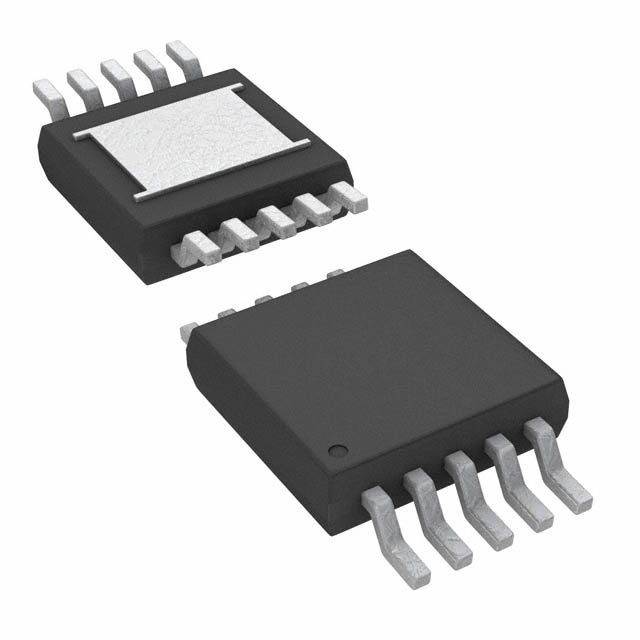LTC2634IMSE-LMX8#TRPBF
Product Overview
Category: Integrated Circuit (IC)
Use: The LTC2634IMSE-LMX8#TRPBF is a digital-to-analog converter (DAC) IC. It converts digital signals into analog voltage or current outputs.
Characteristics: - High precision and accuracy - Low power consumption - Small form factor - Wide operating temperature range - Fast settling time
Package: The LTC2634IMSE-LMX8#TRPBF is available in a MSOP-16 package, which provides a compact and robust solution for various applications.
Essence: This DAC IC is designed to provide accurate and reliable analog output signals in a wide range of electronic systems.
Packaging/Quantity: The LTC2634IMSE-LMX8#TRPBF is typically sold in reels containing 2500 units per reel.
Specifications
- Resolution: 12 bits
- Number of Channels: 1
- Output Type: Voltage or Current
- Supply Voltage Range: 2.7V to 5.5V
- Operating Temperature Range: -40°C to +85°C
- Interface: SPI (Serial Peripheral Interface)
- DNL (Differential Non-Linearity): ±1 LSB (Least Significant Bit)
- INL (Integral Non-Linearity): ±2 LSB
Pin Configuration
The LTC2634IMSE-LMX8#TRPBF has the following pin configuration:
- VDD: Power supply voltage
- GND: Ground reference
- CS: Chip select input
- SCK: Serial clock input
- SDI: Serial data input
- LDAC: Load DAC input
- REF: Reference voltage input
- OUT: Analog output
Functional Features
- High-resolution digital-to-analog conversion
- Programmable output voltage or current levels
- Internal reference voltage for improved accuracy
- SPI interface for easy integration with microcontrollers and other digital systems
- Power-on reset function to ensure proper initialization
Advantages and Disadvantages
Advantages: - High precision and accuracy in analog signal generation - Low power consumption for energy-efficient applications - Compact form factor for space-constrained designs - Wide operating temperature range for versatile usage - Fast settling time for rapid response to input changes
Disadvantages: - Limited number of channels (only 1 channel) - Requires external components for proper operation (e.g., reference voltage)
Working Principles
The LTC2634IMSE-LMX8#TRPBF operates by converting digital input signals into corresponding analog output voltages or currents. It utilizes an internal digital-to-analog conversion algorithm to accurately translate the digital data into precise analog levels. The converted analog signals can then be used as control signals, references, or inputs for various electronic circuits and systems.
Detailed Application Field Plans
The LTC2634IMSE-LMX8#TRPBF finds applications in a wide range of fields, including:
- Industrial Automation: Used for controlling motor speed, valve positions, and other analog control parameters.
- Test and Measurement Equipment: Provides accurate reference voltages or currents for calibration and testing purposes.
- Audio Systems: Generates high-quality analog audio signals for amplifiers, mixers, and other audio equipment.
- Communication Systems: Used in signal conditioning, modulation, and demodulation circuits.
- Medical Devices: Provides precise control signals for medical imaging, patient monitoring, and therapeutic equipment.
Detailed and Complete Alternative Models
- LTC2634IMSE-LMX10#TRPBF: Similar to LTC2634IMSE-LMX8#TRPBF but with a higher resolution of 10 bits.
- LTC2634IMSE-LMX12#TRPBF: Similar to LTC2634IMSE-LMX8#TRPBF but with a higher resolution of 12 bits and dual-channel capability.
- LTC2634IMSE-LMX16#TRPBF: Similar to LTC2634IMSE-LMX8#TRPBF but with a higher resolution of 16 bits.
These alternative models provide options for different resolution requirements and channel configurations, catering to diverse application needs.
Word count: 468 words
Senaraikan 10 soalan dan jawapan biasa yang berkaitan dengan aplikasi LTC2634IMSE-LMX8#TRPBF dalam penyelesaian teknikal
Sure! Here are 10 common questions and answers related to the application of LTC2634IMSE-LMX8#TRPBF in technical solutions:
Q: What is LTC2634IMSE-LMX8#TRPBF? A: LTC2634IMSE-LMX8#TRPBF is a specific model of digital-to-analog converter (DAC) manufactured by Linear Technology.
Q: What is the purpose of LTC2634IMSE-LMX8#TRPBF? A: The purpose of LTC2634IMSE-LMX8#TRPBF is to convert digital signals into analog voltages, making it useful in various applications such as control systems, instrumentation, and communication devices.
Q: What is the resolution of LTC2634IMSE-LMX8#TRPBF? A: LTC2634IMSE-LMX8#TRPBF has a resolution of 12 bits, meaning it can represent analog voltages with 4096 discrete levels.
Q: What is the voltage range of LTC2634IMSE-LMX8#TRPBF? A: LTC2634IMSE-LMX8#TRPBF operates within a voltage range of 0V to VREF, where VREF is the reference voltage supplied to the DAC.
Q: How is LTC2634IMSE-LMX8#TRPBF controlled? A: LTC2634IMSE-LMX8#TRPBF can be controlled using a serial interface such as SPI (Serial Peripheral Interface) or I2C (Inter-Integrated Circuit).
Q: Can LTC2634IMSE-LMX8#TRPBF operate on a single power supply? A: Yes, LTC2634IMSE-LMX8#TRPBF can operate on a single power supply, typically ranging from 2.7V to 5.5V.
Q: What is the settling time of LTC2634IMSE-LMX8#TRPBF? A: The settling time of LTC2634IMSE-LMX8#TRPBF refers to the time it takes for the output voltage to reach within a specified error band after a change in the digital input. It typically ranges from a few microseconds to a few milliseconds, depending on the specific configuration and load conditions.
Q: Can LTC2634IMSE-LMX8#TRPBF be used in precision applications? A: Yes, LTC2634IMSE-LMX8#TRPBF is designed for precision applications, offering low integral non-linearity (INL) and differential non-linearity (DNL) specifications.
Q: Is LTC2634IMSE-LMX8#TRPBF available in different package options? A: Yes, LTC2634IMSE-LMX8#TRPBF is available in various package options, including MSOP-10 and DFN-10, allowing flexibility in board layout and integration.
Q: Are there any evaluation boards or reference designs available for LTC2634IMSE-LMX8#TRPBF? A: Yes, Linear Technology provides evaluation boards and reference designs for LTC2634IMSE-LMX8#TRPBF, which can help users quickly prototype and evaluate its performance in their specific applications.
Please note that the answers provided here are general and may vary depending on the specific datasheet and application requirements.


